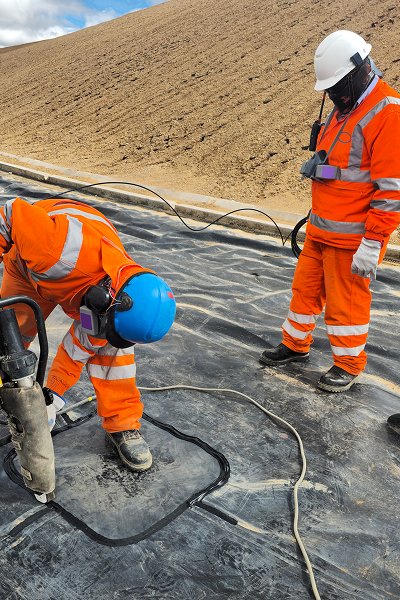What is GCL?
GCL is the abbreviation of Geosynthetic Clay Liner, which is a composite material that sandwiches natural sodium-based bentonite particles between two layers of geotextiles. The bentonite is stabilized by needle punching or gluing to form a thin, flexible, rollable anti-seepage liner.


Basic structure
The basic structure of GCL usually consists of three layers:
Upper layer: non-woven fabric, which plays a protective and reinforcing role;
Middle layer: bentonite particles (mainly sodium-based), which swell after absorbing water to form a low permeability barrier;
Lower layer: woven or non-woven fabric, which enhances tensile properties and fixes the material structure.
GCL Features and Advantages
Ultra-low permeability, excellent anti-seepage ability
The core function of GCL is anti-seepage, and its anti-seepage mechanism mainly relies on the sodium-based bentonite particles in the middle interlayer. This natural mineral has a strong ability to absorb water and swell. After absorbing water, its volume can increase to 15~20 times of its original size, forming a gel-like dense barrier layer, thereby achieving low permeability or even "zero permeability".
After the bentonite layer absorbs water and swells, the permeability coefficient can be as low as 10⁻⁹ ~ 10⁻¹¹ cm/s;
The permeability performance is stable and not easily affected by minor defects;
Even if small cracks or punctures occur, they can be automatically repaired by expansion, which has the advantage of **"self-healing"**
Strong self-healing ability, enhancing engineering safety
Once traditional geomembranes such as HDPE are punctured, they often need to be repaired or replaced by welding. However, the sodium-based bentonite particles in GCL have self-healing function. When microcracks or damage occur, they will quickly fill the pores after absorbing water and restore the dense structure.
Prevent local leakage caused by foundation settlement, small animal burrowing, tree root puncture, etc.;
Fast self-healing speed, self-sealing can be completed within a few hours in a humid environment;
Greatly reduce maintenance costs and manual inspection frequency.
Strong adaptability and wide range of terrain adaptation
GCL has good flexibility and can fit naturally with various terrains, adapt to surface undulations and irregular structures, and is particularly suitable for use in the following environments:
Complex geometric surfaces such as steep slopes, embankments, and ditches;
Areas with frequent terrain changes or where large-scale earthwork excavation is not suitable;
Detailed areas such as narrow spaces, corners, and around pile foundations.
Excellent environmental performance, friendly to the ecosystem
The bentonite used by GCL is a natural mineral with good environmental performance:
Non-toxic and harmless, naturally degradable;
Contains no heavy metals, volatile organic compounds or plasticizers;
Highly compatible with soil, does not affect the growth of vegetation roots;
Simple waste disposal, minimal impact on the environment.
Landfill bottom and cover soil anti-seepage system
Application background:
Modern landfills need to have a good leachate control system to prevent leachate from seeping into the ground and polluting soil and water. GCL is usually part of the landfill anti-seepage system, located under the HDPE membrane, forming a double-layer composite anti-seepage structure.
Application advantages:
Combined with HDPE membrane, it forms a "main membrane + secondary pad" protection;
The bentonite layer can absorb micro-seepage and block the leakage channel through a self-healing mechanism;
Convenient construction, adapting to the undulating terrain of the landfill;
Environmental monitoring has verified that GCL has strong stability against heavy metals and acid-base waste liquids.

Waterproofing of underground building foundations
Application background:
The bases of high-rise building basements, garages, pipe corridors and other structures need to prevent groundwater from infiltrating. Especially in areas with high groundwater levels and frequent rainfall, the requirements for anti-seepage performance are more stringent.
Application advantages:
GCL can be pre-laid on the base or side walls and work together with the structure;
Easy to lay, which helps to save construction time;
Maintain anti-seepage stability under water pressure fluctuations;
The bentonite layer forms a fitting interface after contacting the concrete, which enhances the sealing performance.

FAQ
1. How low can the permeability coefficient of GCL's anti-seepage performance be?
A: The permeability coefficient of GCL in a saturated state can reach ≤1.0×10⁻¹¹ m/s, which is much lower than that of compacted clay layers and some geomembranes, and has very excellent anti-seepage capabilities.
2. Can GCL be used as an anti-seepage layer alone?
A: Yes. In some projects that do not have extremely stringent anti-seepage requirements, GCL alone can meet the requirements. However, in high-risk areas such as landfills and chemical pools, it is recommended to form a composite anti-seepage system with HDPE membranes to enhance overall safety.
3. Will GCL be damaged by plant roots?
A: Generally speaking, no. The waterproof layer formed by the expansion of bentonite has a barrier effect on plant roots. GCL is also commonly used in green slopes, ecological slope protection and other projects. If high-strength root puncture resistance is required, special root-resistant GCL products can also be selected.
4. Is GCL still effective in low temperature or freeze-thaw environment?
A: Yes. Bentonite has good low temperature resistance, and freeze-thaw cycles have little effect on its anti-seepage performance. GCL is suitable for high-cold and seasonally frozen areas, such as the Northwest Plateau or Northeast Mountain Area.


